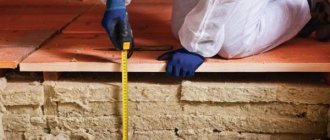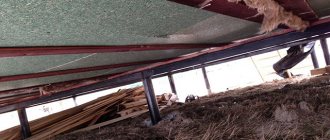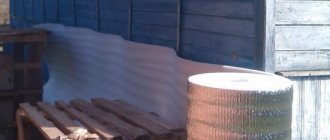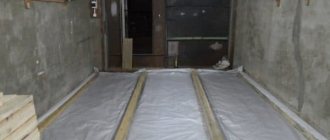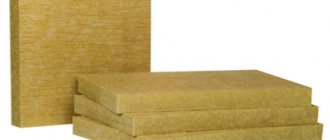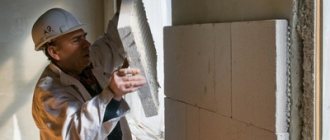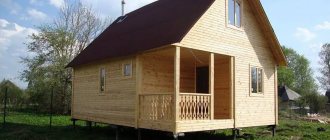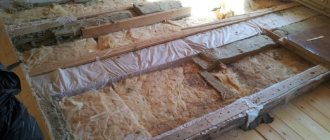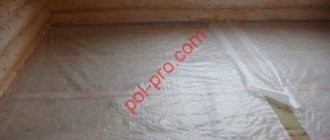When building a house, it is necessary to provide measures for heat - air - steam - waterproofing. If modern materials are used for insulation, then all kinds of films and membranes are a given, which cannot be avoided.
It’s easy to learn how to work with them: instructions for use always accompany the packaging. This is the law. References to houses that have stood for 200 years without any insulation are not accepted.
Human physical contact with building structures is limited to one type: floor. Its temperature determines the comfort in the room.
Floors with joists
Correctly calculated and installed floor insulation in a wooden house is an important component of its energy efficiency. In order not to open the floors after the first winter, you need to think about thermal insulation before making the foundation.
The most common of them are strip, column, pile and pile-screw. As a rule, the base is made with underground space. Ventilations are required. Their task is ventilation, removing moist air that can penetrate the thermal insulation cake of the floor.
The source of increased moisture is soil and condensation on the inside of the foundation at low temperatures. Its amount is reduced by insulating the base, covering the soil with a vapor barrier film, followed by backfilling with a 5-10 centimeter layer of sand.
However, ventilation holes are a must. Clause 9.10 of SNiP 31-01-2003 (SP 54.13330.2011) establishes the total area of vents: 1/400 of the area of the technical underground. In areas with increased radon emissions, their area is 4 times larger.
Is it a lot or a little? Let's calculate: 0.018 is the area of a sewer pipe with a diameter of 150 mm. For a house of 100 m2 you need 0.25 m2. These are 14 vents, evenly distributed around the perimeter. Additional holes are made in the internal tapes.
In practice, designers do not include such a number of ventilation holes. And if they are, then the desire to decorate them reduces the effectiveness by half. A fine wire mesh to protect against rodents is the optimal solution.
If the soil is covered with film (more on this below), some of the vents can be closed after the first frost. Cold air contains little moisture; air draft through open channels will only remove moisture from the insulation.
Why is such a seemingly insignificant detail described in such detail? Because it will not be possible to properly insulate the floor in a private house with a wet underground.
The opposite case: in a frame house on stilts, the basement is closed at best in the second year. The wind is blowing under the floor, fluttering the windproof film, and with it the thermal insulation cake. If there is no such film, then you need to know that blown thermal insulation does not insulate anything.
Have you decided to build a house? Think about the floors right away. Correcting errors in their device is very expensive.
Other materials
Less common thermal insulators are ecowool, sawdust, reed mats, cork, etc. Despite all their naturalness and naturalness, they are quite fire hazardous. Therefore, they need to be used with additional treatment with fire retardants and antiseptics. Accordingly, in terms of harmlessness to humans, they become the same as insulation obtained artificially.
Rodents love natural materials. They make nests under the floor and feel great there. To block their path, the lower surfaces and other possible penetration points are lined with metal or sheathed with fine mesh.
General principles for constructing a thermal insulation pie
There are two options for floors on the ground: with and without underground space along the joists. In 90% of cases the first option is used. It is economical, easy to maintain, and the technology is simple and straightforward. There is no alternative for columnar and pile foundations with a grillage.
When a thermal insulation cake is placed directly on the ground, the preparation of the base - backfill - requires careful layer-by-layer compaction with a force of at least 150 kg. A professional tool is required, the result cannot be controlled. If the backfill height is more than 60 cm, the cost of its installation will be prohibitive.
If the soil settles over time, the floors will have to be redone. You can't do it cheaply.
Let's look at the first option step by step.
There is some space between the soil and the joists. If distance allows, you can insulate the floor in a wooden house from below. If not, work is carried out from above.
The ends of the joists should rest on galvanized steel brackets and not crash into the grillage or timber.
The logs must be planed. This ensures a tight fit of the insulation and films. This is minus 1-2% of total heat loss.
On the logs - the ideal height for the middle strip is 200 mm - a wind-moisture-proof, vapor-permeable membrane is attached to the bottom. The most famous material is isospan A with a density of 110 g/m2. The ideal material is with a density of at least 160 g/m2. Vapor permeability is required: this will allow excess moisture to escape from the insulation.
The load from the insulation is carried by wooden sheathing and metal mesh, nailed to the joists along the wind barrier. All this can be done from below.
If the work is done from above, then the film is nailed from below on two opposite sides of the room and brought to the center. In the last connection, the ends are twisted together, stapled or sewn.
The load from the insulation will be taken by the subfloor: pieces of boards spaced apart (for ventilation of the insulation), laid on a cranial block nailed to the joists. The standard dimensions of such a bar are 50 x 50 mm. Accordingly, the thickness of the insulation is reduced by 50 mm.
With a log height of 150 mm, an insulation thickness of 100 mm will clearly not be enough. We'll have to increase the lag. If this is not done from below, you will have to sacrifice the height of the room. All these nuances must be taken into account in the project.
does happen, the base for the insulation is made of soft wire, twisting it onto screws or nails in the joists like this: Z or N. As a result, they do without cranial bars.
Metal plates can be used. The principle is clear, but they must be fastened so that insulation lies between the joists.
1. Hanging bracket. 2. Spacer plate. 3. External wall. 4. Indoor units. 5. Waterproofing pie on the ground.
The insulation is placed on the base flush with the edge of the lag. Then comes the film. Which?
Partial pressure at a positive temperature inside the building and negative outside “presses” on the floor and walls, tends to penetrate structures and insulation.
Logical conclusion: a vapor barrier waterproof layer should separate the insulation from the atmosphere of the room. Of course it's durable. Izospan B is the most popular, available in every store.
Another quality: the manufacturer claims that the material prevents particles of fibrous insulation from penetrating into the room. It is important. Which side to lay the film on is indicated in the instructions. An overlap of 20–30 cm on the walls is required.
A ventilation gap is installed between the vapor barrier and the finished floor. This is usually the thickness of an inch board. Treatment of wooden structures with protective compounds is mandatory.
Insulation calculation
The thickness of the thermal insulation layer is calculated in accordance with SNiP II-3-79 “Construction Heat Engineering”.
For premises of the first category, housing, the optimal temperature in cold weather is 20 - 22, permissible 18 - 24 ° C (Reference manual to SNiP 23-01-99). The number of degree days (at 20° C indoors) for Moscow is 4400, Krasnoyarsk 5600 (ibid.).
Using Table 4 of SNiP 23-02-2003 (thermal protection of buildings), we determine the value of the resistance to heat transfer of coatings and ceilings over driveways and basements. Yes, floors with underground space are determined by this column. This RQ is 4.2 and 5.2 m2-°C/W, respectively.
The RQ of a meter layer is:
- pine trees 5.6;
- mineral wool 14.3-20.8;
- white expanded polystyrene (foam) depending on density 20-32.3;
- extruded polystyrene foam 27.8;
- polyurethane foam 24.4-50.
These numbers will help determine the approximate thickness of the insulation. For example, the resistance of mineral wool with a layer of 25 cm will be equal to: 20.8 / 4 = 5.2 m2 °C/W.
A complete calculation of the total thermal resistance includes the sum of the values of all layers of the floor cake. You can do it yourself using the TeReMOK program or online calculators. Teremok is good because it carries out calculations for 131 types of thermal insulation materials and indicates the location of the dew point (condensation formation).
Taking into account the fact that insulation standards are constantly becoming stricter, adding 25–50% to the calculated thickness before insulating the floor in a wooden house is the right decision.
Thermal insulation with sawdust
When building a private house made of wood or stone, the developer must solve many problems, and one of them is creating effective insulation of the building.
Thermal insulation with sawdust
There is a large selection of materials on the market for room insulation, in particular floors, but many believe that one of the best options is to use sawdust. At the same time, they are guided by the following criteria of cheapness and environmental friendliness of this material.
Sawdust is considered the lowest cost material that can be used for thermal insulation. This insulation represents waste that is obtained during wood processing. It should be noted that many houses built in the past, or even the century before last, that have survived to this day, are insulated with sawdust and have not lost their thermal insulation properties.
What are the advantages and disadvantages of this material?
The undoubted advantages include:
Cheapness. Many wood processing companies are willing to give this material away for free. In this case, there will be costs for their delivery to the construction site. Sawdust does not emit any harmful substances, they do not cause allergic reactions in residents. In addition, they have high thermal insulation rates; in this parameter they are comparable to mineral wool.
To adequately evaluate this insulation, one cannot fail to mention its shortcomings. These include:
This is a flammable material. They can become a place for small rodents and insects to live
To avoid these shortcomings, cement, gypsum and some other materials are added to sawdust. After obtaining the mixture, it is treated with copper sulfate. As a result of these operations, the sawdust will not burn, and rodents will not like such food.
Types and application of insulation
When choosing insulation, they are guided by cost, thermal insulation properties, and durability. The latter indicator must be comparable to the planned service life of the building before major repairs or demolition.
Recently, environmental safety has been seriously assessed. This is not all right with modern materials. If used incorrectly, there is a chance of developing chronic diseases in the new home.
Detailed thermal characteristics of almost all materials are given in Appendix 3 of SNiP II-3-79 “Construction Heat Engineering”.
Let us briefly describe the main ones.
Mineral wool and fiberglass
Here are mats, slabs made of mineral, glass, glass-staple fiber on an organic, synthetic binder or pierced. Soft, semi-rigid or hard with a density from 50 to 350 kg/m3. The specific heat capacity of all materials in this group is 0.84 kJ/(kg x °C). The thermal conductivity coefficient depends on the density. Within the range of 0.048 – 0.091 W/(m×°C).
The big advantage of mineral wool insulation is that it is a waste-free material. All trimmings and scraps go into use.
Non-flammable (NG), fire-resistant materials (up to 1000° C). Suitable for floor insulation without restrictions.
Toxicity: modern cotton wool does not contain phenols and formaldehyde, there are practically no emissions. It receives a minus in terms of environmental friendliness for the formation of dust from fibers during installation. During the operation of floors with such insulation, a vapor barrier protects the living space from microparticles.
The disadvantage of fiber materials is considered to be high moisture absorption. This is actually not a mineral wool problem. This is the problem of those who lay it down. Without creating an insulation system, part of which is cotton wool, the expected result will not be achieved.
Here we come to the main thing: the material does not forgive mistakes. It serves effectively for quite a long time, provided that it is installed correctly and has proper vapor barrier. This work can only be entrusted to a responsible, qualified builder.
A significant drawback is shrinkage. The higher the density, the lower this value. Wool with a density of 35 kg/m3 over 10 years in floors can decrease in volume by up to 10%. Therefore, they lay it tightly, with compression. This compensates for future shrinkage.
If the decision is made, you should only use material from a well-known brand, in original packaging.
Polymer
For thermal insulation, foamed (polyfoam) or extruded polystyrene (penoplex, EPS), penofol (thin foil polystyrene), PIR, polyurethane foam are used. Density from 20 to 200 kg/m3, specific heat capacity 1.26 – 1.68 kJ/(kg x °C), thermal conductivity coefficient 1.26 – 1.47 W/(m×°C).
Polystyrene is the most famous material: inexpensive, lightweight, easy to install. According to the new GOST 15588-2014 this is PPS, in the old 15588-86 it is PSB.
It is not recommended to insulate a wooden floor with an open surface inside a living space. For the following reasons: it emits styrene; it burns well in wooden structures, producing extremely toxic smoke.
PIR boards (polyisocyanurate) thermal conductivity 0.023 W/(m K), not used for floors for the same reason. Foil has a flammability rating of G 1, low flammability. Covered with paper - G 2, moderately flammable (GOST 30244-94). This material is considered a new product, but in 2022 it was used to burn down the Grenfell Tower of London.
PUR (polyurethane foam) thermal conductivity 0.029 - 0.041 W/(m K) moderately flammable. Rigid in slabs or sprayed directly on the surface by combining two components (spray foam - the same polyurethane foam). The use of open floors for insulation of residential premises is not provided for by regulatory documents.
The penoplex manufacturer recommends a cement-sand screed (for floor tiles) or a prefabricated sheet screed made of 2 layers of gypsum fiber board or other sheet materials with overlapping joints (for linoleum, laminate, parquet) on top of the material.
However, open polymers are used to insulate floors in homes. Those specifically built for sale use only polystyrene. The arguments are clear: cheap and fast.
Insulating the floor with penoplex or extruded polystyrene or other polymer boards and then pouring concrete is a completely safe method. This is the technology used to make a popular foundation: an insulated Swedish slab.
Organic
Quite a large group of materials. A perfectionist developer will give preference only to them.
Expanded clay
The brands are specified in GOST 9757-90. Expanded clay sand, gravel and crushed stone have different thermal conductivity coefficients, from 0.12 to 0.19 W/(m K). It depends on the size of the fraction. The gravel used is light oval elements with closed pores.
Insulating a floor with expanded clay is not labor-intensive and can be done by one person.
Weight from 450 to 600 kg/m3. This is a lot, so more brick columns need to be placed under the logs. Or sew two fifty boards together. Of the required total amount, 10-20% is purchased in smaller fractions to fill hard-to-reach places.
A layer of 200 mm is usually sufficient for the middle strip. And inexpensive. If you need to make a calculation, it is said above how to do it. The technology is similar to laying any insulation. Below there is a wind and water barrier, above the expanded clay there is a vapor barrier flooring.
The use of films is mandatory, since expanded clay is very hygroscopic.
Perlite
Volcanic aluminosilicate rock, expanded by heating.
Both sand (backfill insulation) and a slab with organic or polymer filler are used. Thermal conductivity due to fillers is not very high: 0.118 W/(m °C).
Thermal insulating molded material is used in residential and commercial buildings. Eternal material: does not burn, does not rot, is not interesting to rodents. It is hygroscopic and must be protected from moisture penetration.
Vermiculite
A natural mineral, after heating it turns into worm-like scales. Used as backfill or in slab form (with a reduced thermal conductivity coefficient).
Perlite-like material. Does not cake, does not emit harmful substances, and is not damaged by rodents. Strong, does not wear off into sand like perlite. The country has good reserves of vermiculite, but the high price hinders mass use.
Ecowool
The result of recycling waste paper, cellulose. The addition of 12% boric acid makes it non-flammable, 7% borax is added as an antiseptic.
The disadvantage is the second group of flammability. Apply by fluffing or spraying. Floor insulation in a frame house is carried out according to this scheme.
In terms of heat-saving properties, it is similar to mineral wool and polystyrene foam, but does not generate dust and does not emit harmful substances.
Cork
Modified bark of the tree of the same name. Treated with fire retardant. Flammability G 1. Thermal conductivity - 0.04 ± 0.1 W/mK.
The slabs are produced with a thickness of up to 50 mm. For floors, it is correct to use black agglomerate - the bark of tree branches. The high cost makes such insulation practically inaccessible.
Sawdust
Traditional cheap insulation. It is not used in its pure form. When adding 10% slaked lime, 5% gypsum, the flowability decreases and the material sets. Prepare in small portions. The technology looks like this.
Notation. 1. Laga. 2. Cranial block. 3. Subfloor. 4. Lutrasil, glassine. 5. Sawdust. 6. Milk of lime. 7. Finish wood floors.
Sawdust or shavings are mixed with clay and cement.
Reed mats
Natural material. Flammable Used in the following system.
When the material is inaccessible to fire, moisture, and rodents, it successfully copes with insulation.
Slag
Old, accessible material, but its use has nuances. Fresh slag has a lot of impurities. They are washed out by rain and weathered. This process lasts for months. It is difficult to determine how “fresh” the material was brought.
Boiler slag has a thermal conductivity of 0.29 W/m K. This is a low figure, but if free material is available, it is worth considering this option.
Calculation of thermal insulation thickness
Insulation that is too thin does not provide sufficient heat retention, and it is uneconomical to use insulation that is too thick. Therefore, before starting work, it is recommended to calculate the thickness of the thermal insulation.
It is clear that this value varies in different climatic zones. The colder the weather and the longer the duration of the cold period, the thicker the insulation should be. The calculation is carried out according to the method described in SP 50.13330.2012. The parameters of the building, the characteristics of the enclosing structures, what room the floors are located above, the climate, and much more are taken into account.
First, the SP determines the normalized heat transfer resistance for a specific structure in a given climatic zone and under given operating conditions. Then the total resistance of all floor layers is calculated, taking into account the thermal conductivity coefficient of each material and thermal heterogeneity.
The values are compared. If the resulting resistance is equal to or greater than the normalized one, everything is in order. The thickness of the insulation is sufficient. If not, it is necessary to increase the thermal insulation layer and carry out the calculations again.
Without appropriate preparation, it is difficult to find all the necessary values, so they use ready-made recommendations compiled for a specific insulation and climate zone. For example, a wooden house with a cold underground in the Moscow region will require mineral wool insulation with a thickness of at least 160 mm. In Krasnodar - 110 mm, in Yakutsk - 300 mm. There are also thermal calculators that calculate the thickness of the material based on specified conditions.
Penofol insulation
Insulation with penofol
Penofol is a multilayer material that consists of a base and polished foil. Polyethylene foam of different densities, sizes and internal structures is used as a base. The foil used in penofol is polished to a coefficient of 97%. Its thickness is only 20 microns. It can be applied to both sides of the material. By the way, this material came to us from the space industry. It was used in the production of space suits.
The peculiarity of this material is that it does not retain the heat coming from the room, it reflects it in the opposite direction.
Ecowool
Ecowool
This material is very similar in characteristics to mineral wool, but is made from cellulose fibers, therefore it is absolutely safe for health. Just like mineral wool, ecowool is afraid of water and is easily deformed. Therefore, in most cases it is used to insulate wooden floors between floors.
Ecowool insulation
The big advantage of ecowool is that it is installed by spraying under pressure from a special pipe. Thus, the insulation can be “blown out” under the already assembled floor; for this you only need to make several small technological holes.
Spraying ecowool
The required thickness of the ecowool layer corresponds to the thickness of the mineral wool layer, all other things being equal.
Characteristics of basalt and ecowool
Thermal insulation with expanded clay
Thermal insulation with expanded clay
Expanded clay is a granular material, light in weight and obtained as a result of clay compression. This material is considered natural and environmentally friendly. It has a number of properties that allow it to be used as insulation. Among them are:
- sound insulation – muffles extraneous sounds; retains heat well;
- resistance to low temperatures and it should not be destroyed when exposed to them;
- resistance to high temperatures and open flames;
- strength - this material does not change its structure;
- strength – does not change its structure under the influence of cold/hot water; long service life, it does not change its characteristics under the influence of many factors, including time.
We must not forget about its cheapness. Compared to many modern materials, it is much more profitable to use.
Preparatory work before installation
When laying insulation, it is imperative to use various construction and measuring tools. Regardless of what kind of insulation will be used, the installer must keep a level, tape measure, hacksaw, screwdriver, etc. on hand.
To fasten and close the joints of the waterproofing film, you must use construction tape or polyurethane foam.
If the work is carried out in a house where the floor has already been installed, it is necessary to inspect the load-bearing beams and, if necessary, make minor repairs. You must be prepared for the fact that some of them may have to be replaced.
It wouldn’t hurt to treat them with antiseptic and fire-fighting compounds. By the way, during an inspection, traces of small rodents may be found; accordingly, measures must be taken to prevent their movement in this space.
In addition, it is necessary to remove debris and dust that has accumulated during the use of the floor.
All wooden materials (beams, boards) must be dried. There should be no traces of rotting on their surface
Insulation with isolon
When insulating a floor, the material that is used plays a key role. In recent years, material such as isolon (foamed polyethylene) has been particularly popular. Its use provides the following advantages:
Insulation with isolon
The use of this material allows you to achieve high results with minimal expense.
Foil-coated isolon avoids the use of hydraulic vapor barrier materials. It itself has low vapor conductivity.
Low hygroscopicity allows it to be used in rooms with high humidity without any special preparation.
The thickness of this material ranges from 1 to 5 mm. It is often used as a substrate for laminate or parquet. Its use significantly insulates the floor. In addition, as already noted, its installation avoids the use of vapor barrier films.
Foil-coated isolon is used together with heated floor systems. Heat cables laid on top of foil-coated isolon emit only into the room.

